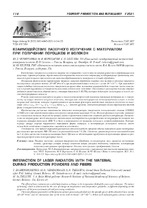Взаимодействие лазерного излучения с материалом при получении порошков и волокон

Date
2021Publisher
Another Title
Interaction of laser radiation with the material during production powders and fibers
Bibliographic entry
Взаимодействие лазерного излучения с материалом при получении порошков и волокон = Interaction of laser radiation with the material during production powders and fibers / Ю. Д. Черниченко [и др.] // Литье и металлургия. – 2021. – № 1. – С. 114-123.
Abstract
Воздействие лазерного излучения на твердое тело приводит к изменению температурного поля обрабатываемого вещества. Характер нагрева, определяющийся скоростями изменения температуры, температурных градиентов, оказывается различным в зависимости от свойств обрабатываемого материала и условий обработки. Основными физическими параметрами процесса лазерной обработки твердых тел являются удельная мощность поглощенного лазерного потока 104–109 Вт/см2 и время взаимодействия металла с лучом 10–5–10–8 с. При взаимодействии подобных импульсов излучения с поверхностью происходит мгновенное взрывоподобное плавление части материала и перевод окружающего поверхность вещества в плазменное состояние. Последующее расширение плазмы сопровождается возникновением ударной волны с пиковым давлением 1–10 ГПа, которая действует на материал, и имеет место диспергирование металла. Решена математическая задача нагрева и плавления цилиндрической пластины нормально падающим на ее поверхность световым потоком лазерного излучения, описываемая системой уравнений теплопроводности в трех сечениях нагреваемой пластины, которые характеризуются временным фактором воздействия лазерного излучения на вещество: 1) 0 ≤ t ≤ tm; 2) t > tm; 3) tm < t ≤ th (здесь tm, th – момент времени, соответствующий началу образования жидкой фазы и завершению плавления пластины). Представлены расчетные зависимости изменения температуры поверхности металлических сплавов Х18Н10Т, Х15Н60 в течение воздействия импульса излучения лазера длительностью τ=5 мс. Наличие фазового перехода, связанного с плавлением металла (перегиб на кривых), ведет к временному снижению скорости роста температуры. Распределение температурных полей показывает значительную неоднородность в распределении температуры по толщине материалов, которая достигает 2000 °C и более в зависимости от толщины металла и условий воздействия. Температурные кривые нагрева поверхности повторяют форму импульса, а температура остального металла имеет нелинейную тенденцию к повышению с выходом на асимптоту. Установлено, что процесс взрывного распыления металла требует прогрева объема материала выше температуры плавления при толщине 300–350 мкм и энергии воздействия 7–8 Дж. Снижение уровня энергетического воздействия до 5–6 Дж и увеличение толщины заготовки более 500 мкм не обеспечивают требуемого для реализации процесса распыления распределения температурных полей.
Abstract in another language
The effect of laser radiation on a solid body leads to a change in the temperature field of the processed substance. The nature of heating, which is determined by the rate of change in temperature and temperature gradients, is different depending on the properties of the processed material and processing conditions. The main physical parameters of the process of laser processing of solids are the specific power of the absorbed laser stream 104–109 W/cm2 and the interaction time of the metal with the beam – 10–5–10–8 s. When such radiation pulses interact with the surface, an instantaneous explosive melting of a part of the material occurs and the substance surrounding the surface is transferred to the plasma state. The subsequent expansion of the plasma is accompanied by the appearance of a shock wave with a peak pressure of 1–10 GPa, which acts on the material, and the metal is dispersed. The mathematical problem of heating and melting a cylindrical plate with a laser light flux that normally affects its surface is solved. this problem is described by a system of thermal conductivity equations in three sections of the heated plate, which are characterized by the time factor of the laser radiation effect on the substance 1) 0 ≤ t ≤ tm; 2) t > tm; 3) tm < t ≤ th (here tm, th is the time moment corresponding to the beginning of the formation of the liquid phase and the end of the melting of the plate, respectively). The calculated dependences of changes in the surface temperature of metal alloys X18N10T, X15N60 during the action of a laser radiation pulse with a duration of τ=5 ms are presented. The presence of a phase transition associated with metal melting (an inflection in the curves) leads to a temporary decrease in the rate of temperature growth. The distribution of temperature fields causes a significant heterogeneity in the distribution of temperature over the thickness of materials, which reaches 2000 °C or more depending on the thickness of the metal and the conditions of exposure. The temperature curves of the surface heating repeat the shape of the pulse, and the temperature of the rest of the metal has a nonlinear tendency to increase with the output to the asymptote. It is established that the process of explosive metal sputtering requires heating the volume of the material above the melting point at a thickness of 300–350 microns and an impact energy of 7–8 J. Reducing the level of energy impact to 5–6 J and increasing the thickness of the workpiece more than 500 microns does not provide the distribution of temperature fields required for the implementation of the spraying process.
View/
Collections
- № 1[22]
